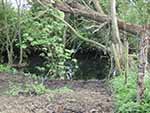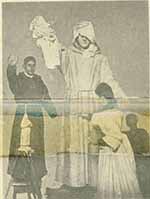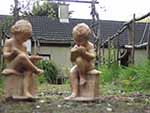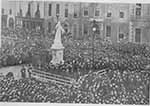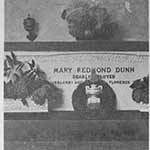Mary Redmond by Nora J Murray (from the Capuchin Annual 1932)
 THE GREAT APOSTLE of Temperance Father Mathew was a Tipperary man, and the sculptor of his statue in O’Connell Street was born in the same county. She is, I believe, the only woman artist to obtain professional status in this form of art that Ireland can boast of, and this is a miniature biography of a “child of the people” who forged her way to success in her own land.
THE GREAT APOSTLE of Temperance Father Mathew was a Tipperary man, and the sculptor of his statue in O’Connell Street was born in the same county. She is, I believe, the only woman artist to obtain professional status in this form of art that Ireland can boast of, and this is a miniature biography of a “child of the people” who forged her way to success in her own land.
Mary Redmond was born in Nenagh in 1863. Her family migrated to Co Kildare where her father obtained work in the then famous limestone quarries at Ardclough, near Straffan. The Redmonds settled in a cottage almost bordering on the quarries. Ardclough was then a thriving rural industrial centre, giving employment to many families in its comfortable little village. A light railway linked the works with the Canal Quay nearby, from which the boats loaded the limestone for Dublin and elsewhere.
The future sculptress had a happy playground beside her home. By one of those happy chances which afford talent its opportunity, the quarry clay had a plastic quality which made it suitable for modelling, and it was in childish recreation with this stimulating medium that the dormant artistic genius of Mary was awakened. There was no plasticine lessons or Montessori system in the schools of those days, so in the evenings, with a healthy creative instinct, she found delight in playing with and pummeling the yellow clay. The familiar things around her birds, hens, ducks and pigs were the subject of her first crude attempts, but gradually bigger efforts materialised when she made dolls for her companions, and a model of the old schoolhouse for her teacher. Little notice was taken of her gift, and she was neither encouraged nor discouraged. One day she modelled a lifelike impression of a travelling woman,” complete with bordered cap, cross-over shawl and all.
A local lady who saw the work advised her parents to send her to Dublin for tuition. Her mother smiled at the suggestion and only wished that “Molly would have less pothering with the clay, for it meant a clean pinafore every morning.” After much persuasion, Mary, now nine and a half years old, was sent to live with friends in Dublin, where she attended a primary school. Eventually she became a pupil of the School of Art, Kildare Street, for tuition in drawing and painting, and in this phase of her study, in open competition, she won her first scholarship, in the Kensington School of Art with a “Head of Brutus.” This was her sesame to her many successes, but still she was not content, for her forte was modelling. With eagerness and determination she visited Farrell’s studio and persuaded him to allow her to do some work. He gave her white pipe clay to experiment with, and in a few days she returned with her first serious model, “A Hand on a Cushion.” Farrell righted its imperfections in this her first lesson and advised her to show t to her teachers in Kildare Street. After this she was given a special corner to mess about it in, and the teachers and students were her first portrait subjects.
Her talent was fostered by the many scholarships she won, and eventually she went to Rome to study under Signor Talloni. When she had finished there she proceeded to Florence where she studied under Signor Bellearti. On his advice she returned to Dublin and opened a studio of her own in Stephen’s Green where she conducted large classes. In open competition she was selected to do the Martin Memorial, which was in the Phoenix Park RIC Depot until after the “change over” when it was removed to the Protestant church in James’s Street.
Amongst her other works were a bust of Gladstone, modelled at his home; a bust of Dwyer Grey (of which thirty repeats were made) a presentation shield to Lord Wolseley, and numerous other portraits and medallions. At this time a pottery factory was mooted, and she made some specimens for the promoters, but their project never materialised.
Her crowning work was the Father Mathew Statue in O’Connell Street, Dublin. The competitors for the work included her first master, Farrell, but all their sketches were rejected by the Committee, which numbered Count Plunkett amongst its members. At the second meeting of the Committee to discuss matters in the Mansion House, Mary Redmond was selected to do the work. In St. Mary of the Angels, Church Street, from the late Father Columbus Maher, OM. Cap., she got the loan of a Franciscan habit. The day of her visit to Church Street the door was opened to her by a brother who fled for the Provincial when a winsome young lady walked in and asked him to “turn around until she had a good look at his habit.” Her first model was an ex-footman whom she found in St Joseph’s Night Refuge, and the fact that he was an “out of work” from Naas influenced her selection.
Everything went on satisfactorily, and the statue was nearing completion when her model began to give trouble. He was “all spread” an artist’s expression for faulty posing. He arrived one morning in the studio very much under the influence of drink (hardly a fit model for Father Mathew) and seeing that her reprimands were fruitless, she dismissed him. Next morning returning to her studio, she found her almost completed work in pieces on the floor. The culprit was sentenced to seven years for his wanton act.
Nothing daunted, she began all over again with a new model, and the day of her triumph eventually came when the statue was unveiled before a large gathering. It is a dignified, virile presentation of the great Apostle of Temperance and Reform Crusader. There is nothing feminine or fussy about it and it compares very favourably with its other neighbours in the street.
Her marriage to Dr. Dunn of Florence took place the same year in London. Although she settled down to domesticity and the care of her two children, she subsequently modelled two beautiful angels for the Church of the Little Company of Mary in Florence, and in her last illness she was nursed by an Irish nun from -that convent, Sister Joseph. She died on the 16th January, 1930.
It is a far way from Ardclough to a sunlit grove in Tuscany. Silence now broods over the quarry of the Little Lakes. Like many thriving centres of those days, an excuse was found for its abolition. Houses were razed to the ground to extend the landlord’s vast grazing demesne, for
- Opulence her grandeur to maintain
- Led stern depopulation in her train.
and today Ardclough is one of the loveliest, but also one of the loneliest places in Ireland.

